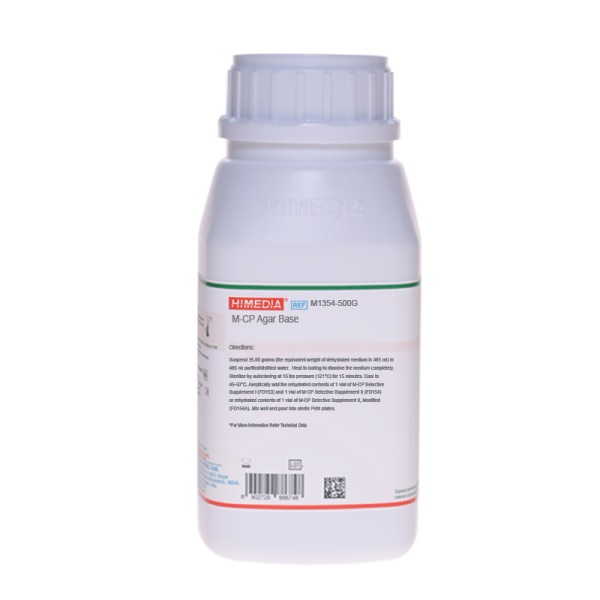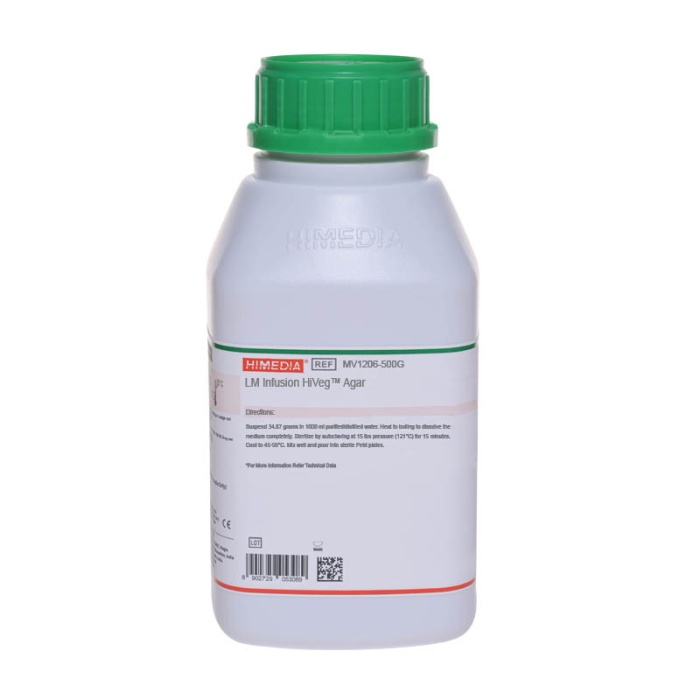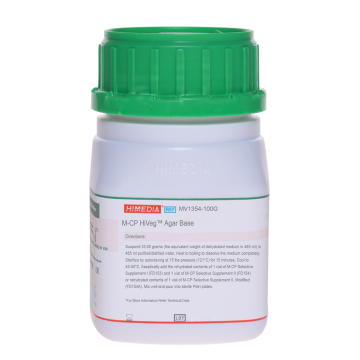 Your enquiry has been submitted
Your enquiry has been submitted
M-CP Agar Base
Intended Use
Recommended by the Directive Council of the European Union 98/83/EC for isolation and enumeration of Clostridium perfringens from water samples using membrane filtration technique.
Composition**
| Ingredients | g/L |
|---|---|
| Tryptose | 30.000 |
| Yeast extract | 20.000 |
| Sucrose | 5.000 |
| L-Cysteine hydrochloride | 1.000 |
| Magnesium sulphate, 7H2O | 0.100 |
| Bromocresol purple | 0.040 |
| Ferric chloride, 6H2O | 0.090 |
| Indoxyl B-D-glucoside | 0.060 |
| Agar | 15.000 |
Final pH (at 25°C): 7.6±0.2
**Formula adjusted, standardized to suit performance parameters
Directions
Suspend 35.60 grams (the equivalent weight of dehydrated medium in 485 ml) in 485 ml purified/distilled water. Heat to boiling to dissolve the medium completely. Sterilize by autoclaving at 15 lbs pressure (121°C) for 15 minutes. Cool to 45-50° C. Aseptically add the rehydrated contents of 1 vial of M-CP Selective Supplement I (FD153) and 1 vial of M-CP Selective Supplement II (FD154) or rehydrated contents of 1 vial of M-CP Selective Supplement II, Modified (FD154A). Mix well and pour into sterile Petri plates.
Principle And Interpretation
Clostridial species are one of the major causes of food poisoning/ gastro-intestinal illnesses. They are gram-positive, spore-forming rods that occur naturally in the soil (1). Among the family are: Clostridium botulinum which produces one of the most potent toxins in existence; Clostridium tetani, causative agent of tetanus; and Clostridium perfringens commonly found in wound infections and diarrhoea cases. The use of toxins to damage the host is a method deployed by many bacterial pathogens. The major virulence factor of C. perfringens is the CPE enterotoxin, which is secreted upon invasion of the host gut, and contributes to food poisoning and other gastrointestinal illnesses (1). Several solid media have been devised for quantitation of C. perfringens. The selectivity of the media is achieved by incorporation of one or more antibiotics that inhibit certain anaerobes or facultative anaerobes.
M-CP Agar Base is prepared as per the formula of Armon and Payment (2). It is also recommended by the Directive of the Council of the European Union 98/83/EC (3) for isolation and enumeration of Clostridium perfringens from water sample using membrane filtration technique.
Tryptose, yeast extract provide nitrogenous, carbonaceous compounds, long chain amino acids, vitamins, minerals and other essential growth factors while sucrose is the fermentable carbohydrate. Bromocresol purple serves as a pH indicator. Indoxyl-ß-D-glucoside is a chromogenic substrate for ß-D-glucosidase or cellobiase and phenolphthalein diphosphate for the detection of acid phosphatase. The addition of D-cycloserine and polymyxin B (FD153) makes the medium inhibitory to accompanying non-clostridial microflora and thus allows analysis of both clostridial vegetative cells and spores. Further selectivity is provided by incubation under anaerobic conditions. Yellow (cellobiase-negative) colonies becoming old rose to pink-red upon exposure to ammonia fumes for 30 seconds are considered to be presumptive C. perfringens. Colour differentiation on M-CP Agar Base is sometimes difficult, so typical colonies (yellow turning into pink) as well as atypical colonies (green or those that remain yellow upon exposure to ammonia fumes) are picked for confirmation. Presumptive C.perfringens can be confirmed by sulphite reduction, gram-positive, sporulating rods, non-motile, reduction of nitrate, gelatine liquefaction, lactose fermentation and other biochemical tests (4).
Type of specimen
Water samples; Food samples
Specimen Collection and Handling:
For water samples, follow appropriate techniques for sample collection, processing as per guidelines and local standards (3,5). For food samples, follow appropriate techniques for sample collection and processing as per guidelines (6).
After use, contaminated materials must be sterilized by autoclaving before discarding.
Warning and Precautions
Read the label before opening the container. Wear protective gloves/protective clothing/eye protection/ face protection. Follow good microbiological lab practices while handling specimens and culture. Standard precautions as per established guidelines should be followed while handling specimens. Safety guidelines may be referred in individual safety data sheets.
Limitations
- Colour differentiation on M-CP Agar Base is sometimes difficult, so typical colonies (yellow turning into pink) as well as a typical colonies (green or those that remain upon exposure to ammonia fumes) are picked for confirmation.
- Due to variable nutritional requirements, some strains may show poor growth on this medium.
Performance and Evaluation
Performance of the medium is expected when used as per the direction on the label within the expiry period when stored at recommended temperature.
Quality Control
Appearance: Light yellow to light green homogeneous free flowing powder
Gelling: Firm, comparable with 1.5% Agar gel
Colour and Clarity of prepared medium: Purple coloured clear to slightly opalescent gel forms in Petri plates
Reaction: Reaction of 7.12% w/v aqueous solution at 25°C. pH: 7.6±0.2
pH: 7.40-7.80
Cultural Response
Productivity: Cultural response was observed after an incubation (anaerobic atmosphere) at 44 ± 1°C for 21 ± 3 hours, with added sterile M-CP Selective Supplement I (FD153) and M-CP Selective Supplement II (FD154) or M-CP Selective Supplement II, Modified (FD154A). Recovery rate is considered as 100% for bacteria growth on Reference medium - Soyabean Casein Digest Agar (Tryptone Soya Agar).
Specificity: Cultural response was observed after an incubation (anaerobic atmosphere) at 44 ± 1°C for 21 ± 3 hours, with added sterile M-CP Selective Supplement I (FD153) and M-CP Selective Supplement II (FD154) or M-CP Selective Supplement II, Modified (FD154A).
Selectivity: Cultural response was observed after an incubation (anaerobic atmosphere) at 44 ± 1°C for 21 ± 3 hours, with added sterile M-CP Selective Supplement I (FD153) and M-CP Selective Supplement II (FD154) or M-CP Selective Supplement II, Modified (FD154A).
| Organism | Inoculum (CFU) | Growth | Recovery | Phosphatase test(on exposure to ammonia |
|---|---|---|---|---|
| Productivity | ||||
| Clostridium perfringens ATCC 13124 (00007*) | 50-100 | good-luxuriant | >=50% | positive, yellow coloured colonies (colonies become old rose to light pink-red on exposure to ammonia fumes for 30 seconds) |
| Clostridium perfringens ATCC 10543 (00174*) | 50-100 | good-luxuriant | >=50% | positive, yellow coloured colonies (colonies become old rose to light pink-red on exposure to ammonia fumes for 30 seconds) |
| Clostridium perfringens ATCC 12916 (00080*) | 50-100 | good-luxuriant | >=50% | positive, yellow coloured colonies (colonies become old rose to light pink-red on exposure to ammonia fumes for 30 seconds) |
| Specificity | ||||
| Clostridium bifermentans NCTC 506 (00079*) | 10³-10⁴ | growth | negative, blue coloured colonies | |
| Selectivity | ||||
| Escherichia coli ATCC 8739 (00012*) | >=10⁴ | inhibited | 0% | |
| Escherichia coli ATCC 25922 (00013*) | >=10⁴ | inhibited | 0% | |
Key; (*) Corresponding WDCM numbers
Storage and Shelf Life
Store between 15-25°C in a tightly closed container and the prepared medium at 2-8°C. Use before expiry date on the label. On opening, product should be properly stored dry, after tightly capping the bottle in order to prevent lump formation due to the hygroscopic nature of the product. Improper storage of the product may lead to lump formation. Store in dry ventilated area protected from extremes of temperature and sources of ignition Seal the container tightly after use. Product performance is best if used within stated expiry period.
Disposal
User must ensure safe disposal by autoclaving and/or incineration of used or unusable preparations of this product. Follow established laboratory procedures in disposing of infectious materials and material that comes into contact with sample must be decontaminated and disposed of in accordance with current laboratory techniques (7,8).
Reference
- Czeczulin J. R., Hanna P. C., Mcclane B. A., 1993, Infect. Immun., 61: 3429-3439.
- Armon R. and Payment P., 1988, Can. J. Microbiol., 34:78-79.
- Directive of the Council of the European Union 98/83/EC
- Sartory D. P., Field M., Curbishley S. M., Pritchard A. M., 1998, Lett. Appl. Microbiol., 27:323-327.
- Lipps WC, Braun-Howland EB, Baxter TE,eds. Standard methods for the Examination of Water and Wastewater, 24th ed. Washington DC:APHA Press; 2023.
- Salfinger Y., and Tortorello M.L. Fifth (Ed.), 2001, Compendium of Methods for the Microbiological Examination of Foods, 5th Ed., American Public Health Association, Washington, D.C.
- Isenberg, H.D. Clinical Microbiology Procedures Handbook 2nd Edition.
- Jorgensen, J.H., Pfaller, M.A., Carroll, K.C., Funke, G., Landry, M.L., Richter, S.S and Warnock., D.W. (2015) Manual of Clinical Microbiology, 11th Edition. Vol. 1.
| Product Name | M-CP Agar Base |
|---|---|
| SKU | M1354 |
| Product Type | Regular |
| Physical Form | Powder |
| Origin | Animal |
| Packaging type | HDPE |
| References | 1. Czeczulin J. R., Hanna P. C., Mcclane B. A., 1993, Infect. Immun., 61: 3429-3439. |
| Customized Product Available | No |









